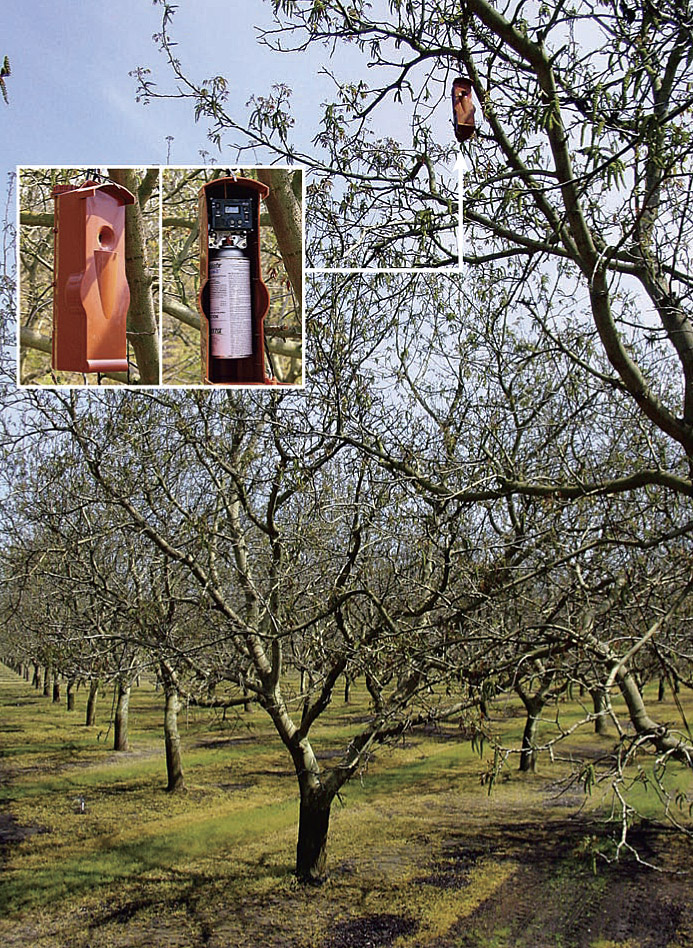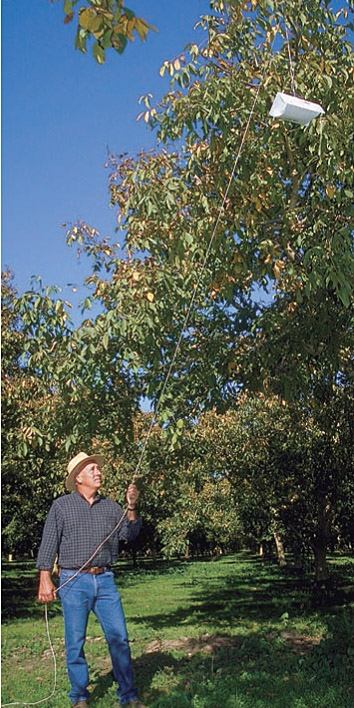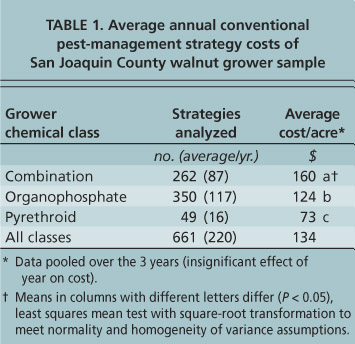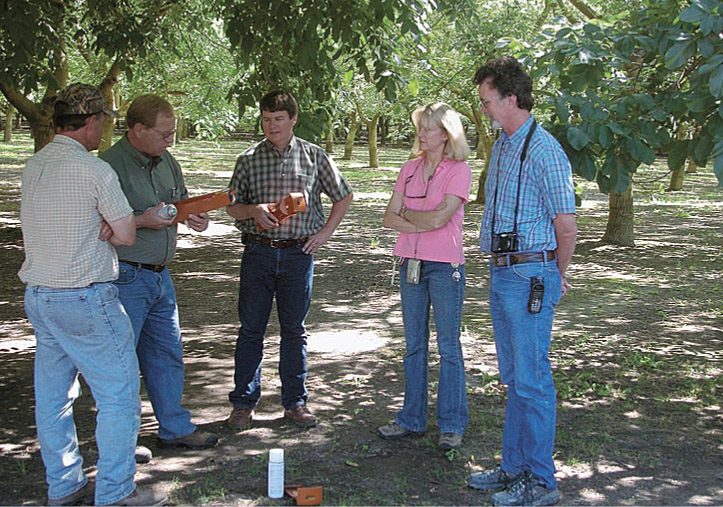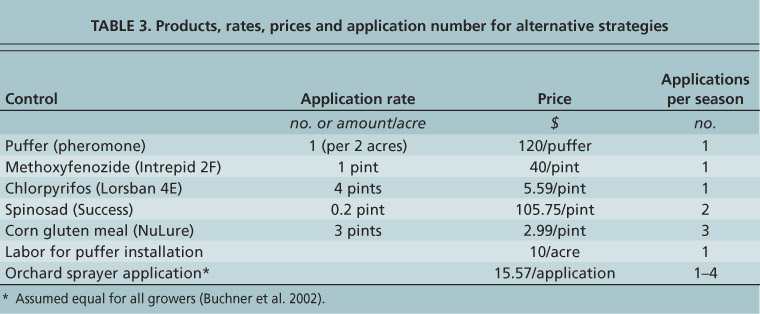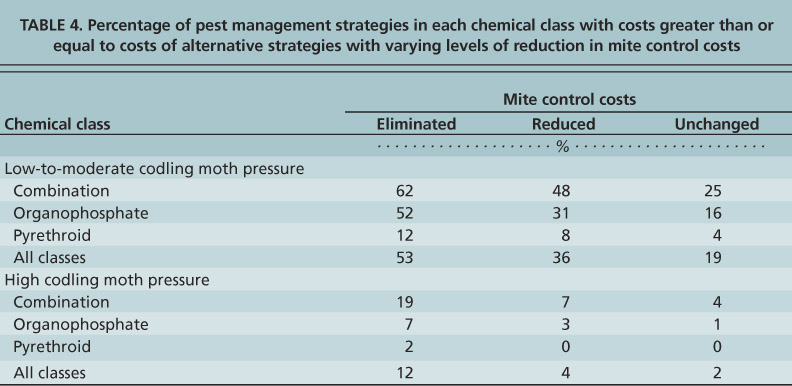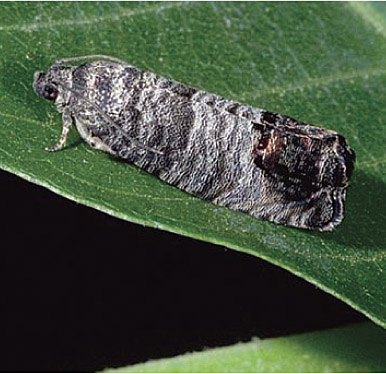All Issues
Pheromone-based pest management can be cost-effective for walnut growers
Publication Information
California Agriculture 62(3):105-110. https://doi.org/10.3733/ca.v062n03p105
Published June 01, 2008
PDF | Citation | Permissions
Abstract
Many organophosphate and pyrethroid insecticides currently used by California walnut growers have been linked to negative environmental or human health impacts, increasing the probability of use restrictions and phase-outs. We assessed the acceptability of alternative reduced-risk strategies by comparing their costs to those of pest management programs currently in use among San Joaquin County walnut growers. To do this, we analyzed data from the California Department of Pesticide Regulation's legally mandated Pesticide Use Reports on actual pesticide applications for 3 years, from 2002 to 2004. While many factors other than cost influence growers’ pest management choices, we found that alternative strategies can be cost-competitive with conventional approaches, depending on the pest pressure and savings due to reductions in secondary pest outbreaks.
Full text
California produces 99% of walnuts nationwide, and this commodity is ranked 14th in the state with an annual value of $610 million (USDA 2006). The most important walnut pests that can cause significant economic loss are codling moth (Cydia pomonella) and, in certain areas, walnut husk fly (Rhagoletis completa). Webspinning mites (Tetranychus spp.) and aphids (primarily Chromaphis juglandicola) can also cause economic damage if not controlled by natural predators. The current management of these pests is based on periodic treatments with organophosphates, pyrethroids, growth-regulating insecticides and miticides.
Important pests of walnuts include codling moth, walnut husk fly, navel orangeworm, aphids and mites. Alternative, reduced-risk pest control strategies, such as pheromone “puffers” for codling moth (shown), were compared with strategies currently in use by walnut growers in the San Joaquin Valley.
However, many products frequently used by walnut growers are being reevaluated for reduction or elimination by regulatory bodies due to adverse human health or environmental risks. For example, 22 of the 30 active ingredients used to control walnut arthropod pests such as codling moth, walnut husk fly, aphids and mites from 2002 to 2004 could be affected by proposed changes stemming from the federal Food Quality Protection Act (FQPA) of 1996. In addition, nine of these 30 active ingredients are currently listed as impairing California water bodies under the Clean Water Act of 1972, and more are likely to be listed as water quality monitoring is extended to additional insecticides and miticides (USEPA 1997, 2002; CDPR 2005).
Because some of these pesticides are broad spectrum and have long residual activity, they kill beneficial insects as well as the targeted pests. The loss of beneficial insects can result in outbreaks of secondary pests such as mites and aphids, necessitating additional treatments and further increasing the potential for negative environmental impacts (Agnello et al. 2003; Prischmann et al. 2005; Zalom et al. 2001).
Stemming from impending regulatory changes as well as growers’ heightened awareness of environmental and worker safety, new technologies have emerged in the form of alternative, lower risk products for controlling arthropods. These include pheromone mating disruption, biopesticides and growth-regulating insecticides. Mating disruption works through the inundation of an orchard with synthetic chemicals designed to mimic pheromones that are released by females to attract males of a species, thus decreasing the male's ability to locate a female and successfully mate. Biopesticides are microbial and biochemical controls with microorganisms naturally antagonistic toward pests, while insect growth regulators disrupt hormone functions responsible for molting, maturation and other insect life-cycle processes. Although varying in their modes of action, these new, narrow-spectrum alternatives selectively control pests and are less disruptive to beneficial insects and mites. Many of these new approaches also reduce the risk that orchard pesticide applications will adversely affect wildlife, water quality and human health (USEPA 2006).
Recent studies have documented the effectiveness of certain alternative strategies for controlling codling moth and walnut husk fly in walnuts (Coates et al. 2001; Flora et al. 1999; Pickel et al. 2007; Van Steenwyk et al. 2005), and growers have begun integrating some of these approaches into their orchard management programs. However, alternative approaches may be more expensive due to an increased number of applications, higher material costs, a greater time commitment for orchard pest monitoring, and lower numbers of pest species controlled per application. Because growers will not broadly adopt alternative technologies unless they are effective and economical, we compared the costs of selected alternative strategies to those of conventional strategies for controlling key pests of walnuts.
Conventional strategies and costs
The first step in comparing the economic feasibility of alternative and conventional strategies was to define the specific products, use rates and application costs associated with each strategy. To define conventional strategies, we used actual grower data from the California Department of Pesticide Regulation's Pesticide Use Reports (PUR), a public database of legally mandated pesticide application reports (CDPR 2005). The PUR database offers a wealth of information about California growers’ pesticide use, including active ingredients, amount per acre applied and number of applications per season. This allowed us to compile comprehensive, detailed and accurate representations of individual grower's pest management strategies based on reported pesticide use in the study area.
We analyzed PUR data for walnut orchards in San Joaquin County for 2002 through 2004. San Joaquin County is California's leading walnut-producing county, with just under 32,000 acres of orchards accounting for about 16% of the annual walnut crop value statewide (CASS 2004). From 2002 to 2004, 372 to 384 San Joaquin County walnut growers reported pesticide use in the PUR database (CDPR 2005).
For each of the 3 years studied, we created a subset of the PUR database that included only those growers who appeared to have treated solely for codling moth, or for codling moth plus other pests, based on product choice and timing criteria. Codling moth was the focal pest for defining the project's PUR subset for analysis, given its economic importance as a walnut pest and the promise of pheromone mating disruption as an effective control. However, for each grower in the subset, the grower's pest management strategy was defined as all of the arthropod pest controls used throughout the entire season on all orchards listed under a grower's PUR identification number. Therefore, the pest management strategies of a single grower could have been included for 1, 2 or all 3 years, depending on whether they treated for codling moth in a given year. As a result, there were approximately 220 pest management strategies analyzed each year, with a total of 661 strategies over the 3 years combined.
Integrated pest management, along with new technologies such as pheromone mating disruption, biopesticides and growth-regulating insecticides, help to protect farmworkers and the environment. Retired Butte County farm advisor Bill Olson monitors for codling moth by hanging traps in walnut orchards.
We calculated the costs of conventional strategies reported in the PUR database using the amounts of product applied per acre and their 2003 prices, and adding a standardized cost for each application in a treatment that covered fuel, labor and maintenance. We assumed that all pesticide applications were made by a conventional orchard air-blast sprayer. Multiple pesticides reported by a grower on the same date and same acreage were assumed to be combined into a single “tank mix” application. All insecticide and miticide costs were then summed to arrive at a total pest-management strategy cost per acre for each grower's conventional strategy in each year.
TABLE 1 Average annual conventional pest-management strategy costs of San Joaquin County walnut grower sample
We compared costs for the entire subset of pest management strategies in the PUR database for a given year, as well as divided the subset into three groups based on the predominant chemical class of FQPA-targeted insecticides used to control codling moth, aphids and walnut husk fly: organophosphate, pyrethroid or a combination of the two. Therefore, while a single grower could potentially contribute up to three pest-management strategies to the analysis, the chemical class could vary annually, depending on the grower's product choice in a given year.
Combining the 3 years studied, 53% of all growers’ pest management strategies were classified as organophosphate, 7% were pyrethroid and 40% were combinations of the two (350, 49 and 262 strategies, respectively). Control costs varied widely within each group depending on the products used, their rates and the number of applications per season, but there were significant differences among the groups’ total costs (table 1). Combination strategies had the highest average annual control costs at $160 per acre, followed by organophosphate at $124 per acre and pyrethroid at $73 per acre.
While many walnut growers are trying out alternative pest-control strategies, the analysis of California Pesticide Use Reports from 2002 to 2004 found that actual adoption rates are low. Left to right, Rick Enos of Carriere Farms, Tom Larsen of Suterra, Bill Carriere, Christine Abbott of Suterra and Glenn County farm advisor Bill Krueger learned about pheromone puffers at Carriere Farms in Glenn County.
Alternative strategies and costs
Based on recent research and the advice of experts, we created alternative pest-management strategies that are both low environmental risk and considered effective for controlling codling moth, aphids and walnut husk fly at levels commonly encountered in the study area (table 2). All the strategies were based on the control of codling moth using pheromone mating disruption (E,E,-8,10-Dodecadien-1-ol) dispensed with bulk aerosol “puffers,” which saturate the orchard atmosphere with pheromone for up to 180 days through regularly timed releases (Suterra, LLC).
Recent research has shown that in orchards with low or moderate populations, pheromone puffers can provide control of codling moth equivalent to that of conventional pesticides (Pickel et al. 2007). For orchards with severe codling moth infestations, one or more supplemental insecticide applications may be necessary to achieve control comparable to that of conventional spray programs. We created and analyzed two pheromone-based alternative strategies judged capable of providing control under varying degrees of codling moth pressure: one in which pheromone puffers were the only method of control, and another of puffers plus a single supplemental application of the insect growth regulator methoxyfenozide (Intrepid).
Both alternative strategies also included a single application of chlorpyrifos (Lorsban) to control aphids. Chlorpyrifos is an organophosphate of regulatory concern, but there were no effective reduced-risk products available for controlling aphids in walnuts at
the time of the study. The chlorpyrifos rate used for our alternative strategies is adequate to provide good control of aphids while reducing the risks of disrupting biological control in the orchard, as well as off-site environmental effects. To control walnut husk fly (in addition to codling moth), our alternative strategies included two alternate-row applications of spinosad (Success), a selective microbial insecticide, along with a feeding-attractant corn gluten meal bait (NuLure). This bait was also included with the chlorpyrifos application for aphids, so as to attract walnut husk fly and allow chlorpyrifos to simultaneously serve as both a walnut husk fly and aphid control. Navel orangeworm was not analyzed because its life cycle did not significantly overlap with codling moth's, and most growers in the county did not consider it an important pest.Study assumptions
Although the PUR does not require growers to report what pests a pesticide application is meant to control, we inferred which pests were targeted based on the product used, time of application, advice of experts and results of a 2005 survey of San Joaquin walnut growers about their specific problem pests and the products they use to control these pests (Steinmann et al., unpublished). Because growers sometimes use the same materials and application timings for controlling codling moth and aphids, treatments for these pests could not be distinguished from one another in our analysis. All growers were therefore assumed to control for aphids as well as codling moth.
Similarly, we could not determine if a grower had high or low codling moth pressure based on the PUR data. Given the focus of this paper on codling moth and pheromone mating disruption, we decided to assess the sensitivity of our results to codling moth pressure by running the analysis under two blanket assumptions. The first analysis assumed that all growers have a low-to-moderate codling moth pressure, and therefore puffers were enough to control codling moth. The second analysis assumed that all growers have high codling moth pressure, and therefore the
insect growth regulator methoxyfenozide was also required to control codling moth effectively.Walnut husk fly treatments in our alternative strategies were applied to every other tree row, based on the results of recent efficacy studies (Van Steenwyk et al. 2005). The calculated costs of four alternative strategies for controlling codling moth and aphid alone — or codling moth, aphid and walnut husk fly — ranged from $108 to $248 per acre, depending on codling moth pressure and other target pests (tables 2 and 3). Mite controls were not included in these hypothetical alternative-strategy cost values, so that they could be added selectively based on varying biological control effectiveness assumptions.
Mite control
In a variety of field and orchard crops, broad-spectrum insecticides may disrupt the biological control of mites, triggering secondary mite outbreaks that necessitate further pesticide use (Agnello et al. 2003; Prischmann et al. 2005; Zalom et al. 2001). In many instances, substituting more-selective insecticides has helped reduce the severity of these secondary mite infestations and in turn the overall costs of managing orchard pests. While such effects have neither been confirmed nor ruled out for walnuts so far, reductions in mite control costs could significantly increase the economic feasibility of alternative approaches.
To predict how reduced miticide use would affect the economic feasibility of our alternative strategies for controlling codling moth, aphid and walnut husk fly, we assessed three possible mite management outcomes:
-
(1) Eliminated. Biological control maintains mites below economically damaging levels; grower's miticide costs, per the PUR database, were not added to the costs of the alternative strategies.
-
(2) Reduced. The narrow-spectrum nature of the alternative strategy allowed for some improvement in biological mite control; half of the grower's reported miticide costs were added to the costs of the alternative strategies.
-
(3) Unchanged. The use of alternatives had no effect on mites; all of the grower's reported miticide costs were added to the costs of the alternative strategies.
Economic feasibility
While many factors influence growers’ choices of pest management strategies, we chose to assess the feasibility of alternative over conventional strategies by comparing their costs. To estimate the share of growers who would consider an alternative strategy economically feasible, we proposed that growers would adopt the strategy if its cost was equal to or less than that of their current conventional strategy. Using this criterion for economic feasibility, we calculated the percentages of growers’ pest management strategies for which costs are greater than or equal to that of the various alternative strategies. The implication is that these alternative strategies would be economically feasible for controlling codling moth, aphid, mite and walnut husk fly under matching presence and abundance of these pests in their orchards.
TABLE 4. Percentage of pest management strategies in each chemical class with costs greater than or equal to costs of alternative strategies with varying levels of reduction in mite control costs
Under the best-case scenario with low-to-moderate codling moth pressure, coupled with no secondary pest mite infestation, the pest control costs for 53% of the reported pest management strategies were greater than or equal to the cost of the associated alternative strategy (table 4). Breaking the conventional strategies down by chemical class, we found that costs were greater than or equal to the alternative strategy for 62% of those that combined organophosphate and pyrethroid, 52% of organophosphate strategies and 12% of pyrethroid strategies.
However, under the assumption of high codling moth pressure requiring a supplemental insecticide application, coupled with no secondary pest mite infestation, only 12% of the conventional pest-control strategies were more costly than or equal to the alternative strategies. Again, breaking the conventional strategies down by chemical class, costs were greater than or equal to the alternative strategies for 19% of combination strategies, 7% of organophosphate strategies and only 2% of pyrethroid strategies.
The feasibility of alternative strategies also dropped when we added half or all of PUR-derived mite control costs to reflect poorer biological control of these pests. With low codling moth pressure, adding half of the reported mite control costs reduced the economic feasibility of the alternative strategies from 53% to 36%. When all of the reported mite-control costs were added, the alternative strategies’ economic feasibility dropped even further to 19%. When codling moth pressure was low-to-moderate and half of the miticide costs could be saved, only 48% of combination strategies, 31% of organophosphate strategies and 8% of pyrethroid strategies had costs greater than or equal to those of the alternative strategies. When mite control costs were unchanged, these figures dropped further to 25%, 16% and 4%, respectively.
Finally, for high codling moth pressure, adding half of mite control costs dropped the alternative strategies’ economic feasibility from 12% to 4%. When full mite control costs were included, economic feasibility dropped even further to only 2%. When miticide costs were reduced by half, 7%, 3% and 0% of combination, organophosphate and pyrethroid strategies, respectively, had costs greater than or equal to those of alternative strategies. When miticide costs remained unchanged, these figures were 4%, 1% and 0%, respectively.
In three important respects, our alternative strategies were constructed conservatively and, as such, may be more acceptable among walnut growers than our findings indicate. First, recent findings from large-scale pheromone puffer trials in walnuts suggest that repeated use over several years can reduce codling moth to acceptable levels even in orchards with high populations (Pickel et al. 2007). Second, we assumed that all growers use a low-dose application of chlorpyrifos to control aphids, but not all orchards are treated for aphids each year. In a 2006 survey of San Joaquin County walnut growers, for example, only 48% of respondents reported treating for aphids (Steinmann et al., unpublished). Third, we assumed that alternatives must have an equal or lower cost than conventional strategies to be acceptable, but growers may elect to use alternative strategies even if they are more costly than conventional approaches.
For example, in a 2002 survey of San Joaquin County walnut growers by the UC Sustainable Agriculture Research and Education Program (SAREP), 56% of 299 respondents agreed “somewhat to strongly” with the statement, “It's worth using practices that reduce my overall chemical use even when it might take a little more expense” (Beverly Ransom et al., unpublished). Similarly, a 1999 analysis of U.S. Midwestern corn and soybean farmers showed that they would be willing to pay an average of $8.25 per acre more for alternative farming practices that reduced risks to the environment (Lohr et al. 1999). The reasons for such willingness may include real or perceived reductions in risks to worker health, orchard ecology or the environment, and the proximity of the farming operation to urban areas, homes and schools.
Low adoption rates
Our analysis of PUR-reported pesticide use showed that many growers have not adopted alternative pest-management strategies despite their willingness to incur slightly higher costs when surveyed in 2002. Over the 3 years of our study, for example, only 13% to 17% of growers used at least one application of an alternative product during the growing season. Of these growers, 58% to 63% used more than one application of broad-spectrum insecticide in addition to the alternative products. Only 5% to 7% had strategies that included broad-spectrum materials at lower rates that were roughly equivalent to those used in our alternative strategies.
There are many possible reasons for the low rate of adoption among growers, including lack of familiarity, higher material costs, risk of lower yields and revenues due to lower efficacy, and new requirements for increased monitoring and attention to the timing of applications. Our results suggest that the alternative strategies we analyzed compare favorably in cost to conventional strategies currently in use by a large portion of walnut growers in the study area, dependent on the effectiveness of biological control. The highest percentages of conventional pest-management strategies that could be most feasibly replaced by an alternative strategy appear to be those employing a combination of organophosphates and pyrethroids throughout the season, followed by those using predominantly organophosphates.
Due to their low cost, pyrethroid strategies would be the least likely to be replaced by alternative strategies. The low cost and high efficacy of pyrethroid insecticides, in conjunction with the current regulatory focus on restricting the use of organophosphates, have made pyrethroids an attractive option for growers. However, the future availability of pyrethroids is threatened by recent studies on the adverse environmental impacts of these materials and on the risk that increased use may accelerate pest resistance (Belden and Lydy 2006; Brun-Barale et al. 2005).
Adoption of alternative strategies
Our results suggest that significant reductions in pesticide use could be achieved through the broader adoption of alternative strategies in the study area. For example, over the three study years, 21,665 acres were treated at an average use rate of 3.75 pounds per acre of FQPA-targeted insecticides and miticides. Under our best-case alternative strategy of low-to-moderate codling moth pressure and the complete elimination of miticides, this rate could be reduced by 43% to 2.13 pounds per acre. Even under the worst-case scenario of high codling moth pressure and unchanged miticide costs, the use of FQPA-targeted pesticides would be reduced by around 6%.
These results open new doors toward potential areas of study that can foster improvements in many already-existing alternative pest controls. As research continues to unveil the interactive dynamics of pests, natural predators and their orchard environment, as well as new ways to manipulate these interactions, there is great potential for increasing the use of existing reduced-risk products and for the development of new ones. Although many unknowns remain, our analysis suggests that alternative, narrow-spectrum pest control strategies such as pheromone puffers may be both economically and environmentally viable in the long run, contributing to sustainable walnut production that is beneficial to growers, consumers and the environment.



